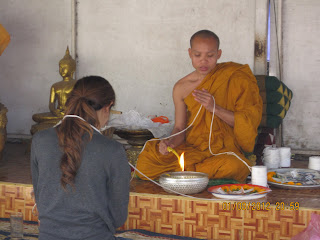 K is not the only person in our group who has lost people here. I feel very fortunate that my Dad stayed safe. He flew into some dangerous areas, and the barracks at Long Tien were shelled during a week he was NOT there, thank God.
K is not the only person in our group who has lost people here. I feel very fortunate that my Dad stayed safe. He flew into some dangerous areas, and the barracks at Long Tien were shelled during a week he was NOT there, thank God.Long Tien, not too far from Luang Prabang, upcountry. Base for the CIA's partnership with Hmong fighters against Pathet Lao.
There is an interesting read in the Lao Airline magazine, Champa Holiday, about this history. The Hmong are portrayed as misguided pawns of the US and Hmong General Vang Pao, refusing the helping hand of the new Lao regime at the end of the war due to misinformation given to them. The magazine article attempts to ride a fine line between chastising the Hmong for fighting, while also proudly stating how the Hmong are now allowed full citizenship and an equal place in society.
 Lao T-28 aircraft destroyed on the site, Long Tien, ca 1969. Dad took this shot.
Lao T-28 aircraft destroyed on the site, Long Tien, ca 1969. Dad took this shot. I wish he was still around - he would have gotten great joy out of this trip.
As we come to our final dinner in Vientiane, I will at last give you foodies something to think about. The food in Laos is fantastic, using many mild flavors like lemongrass and coconut, and chicken, fish, and beef. Honestly, I wish I knew what was in this stuff. But absolutely delicious, and this special meal at the Don Chan, with the American Ambassador to Laos meeting with us, was unforgettable. (did I mention the baguettes and croissants on the street?)
Best Spring Rolls ever. Couldn't be any fresher.

Here is where to go. Don't tell everybody.
 Miscellaneous shot of the gang on our mission to get sarongs made for our dinner - We had no idea what we were getting into. Pick the cloth, the top, go to the tailor - voila!
Miscellaneous shot of the gang on our mission to get sarongs made for our dinner - We had no idea what we were getting into. Pick the cloth, the top, go to the tailor - voila!Below is just one of many places within Talat Sao Mall to pick a top for our sarongs. And then this woman created our sarongs from our chosen cloth, and it was delivered to us.


And we are saving them for our next reunion!!

Again, apologies for my food ignorance. You will simply have to go find out.
Fruit art alone is worth the journey.

The Ambassador to Laos, Karen Stewart, was kind enough to address our group, and let us in on what is happening now in our relations. Some sobering thoughts, but much good news as well. Infant mortality, women's rights, and education are all big agenda items, and progress is being made. Education is a big key to the other issues of course, and US NGOs and government agencies as well are working to improve access to basic education. Girls are given particular focus, to lower risk of human trafficking and improve health for mothers and babies. There is still a long way to go. The modern improvements are not, by a long shot, the whole story of Laos. As we move on to Luang Prabang, I will get a chance to become more involved as Big Brother Mouse takes us off the beaten path.


























.jpg)





















